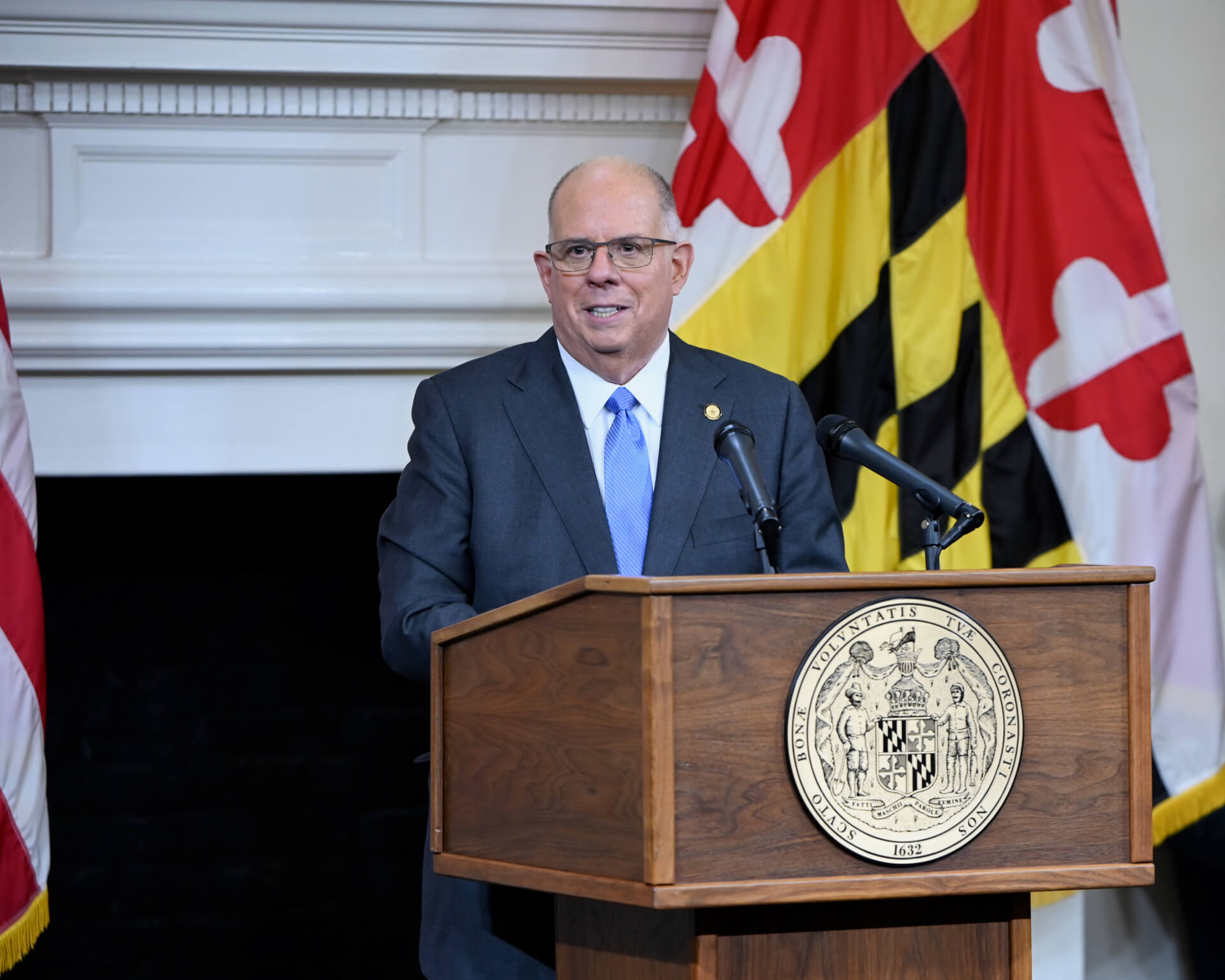Hogan’s Stimulus Plan Gets First, Brief Airing in Senate

Administration officials pressed senators to quickly pass Gov. Lawrence J. Hogan Jr.’s (R) proposed COVID-19 relief package at a Tuesday hearing.
Hogan has urged Maryland lawmakers to move swiftly on his billion-dollar relief package — and on Tuesday, the state stimulus proposal got its first hearing in the Senate Budget and Taxation Committee.
The governor’s Recovery for the Economy, Livelihoods, Industries, Entrepreneurs, and Families (RELIEF) Act would be funded through a mix of tax cuts and relief funding from the state’s Rainy Day Fund. It would provide tax cuts for both businesses and individuals, and direct payments to low-to-moderate income Marylanders.
Maryland Commerce Secretary Kelly M. Schulz noted that the state government has already issued about $700 million in relief aid to businesses and individuals, but said that many Marylanders continue to struggle.
“As the pandemic has dragged on, it hasn’t been enough,” Schulz said. “Many businesses have had to close. Thousands of Marylanders are still out of work. Marylanders need more relief.”
Isabel Molina, a Marylander who said she was furloughed by Johns Hopkins Medicine International and eventually laid off in the early days of the pandemic, also supported the governor’s relief proposal.
Molina said has since struggled to find employment. She said she has been receiving unemployment benefits and that she opted not to have taxes taken out of her unemployment payments.
“I cringe at the thought of having to file taxes this year,” Molina said.
Sen. Guy J. Guzzone (D-Howard), chair of the Budget and Taxation Committee, said there is “a lot of good stuff” in the package.
“I’m not one who believes the government can solve every problem, but we can certainly step up and hopefully do a great job of laying the framework,” Guzzone said.
Senate leaders plan to unveil their COVID relief legislation package during a virtual news conference Wednesday.
According to a fiscal analysis of the Hogan bill by the Department of Legislative Services, general fund revenues will fall by $767.6 million in fiscal year 2021, and $92.5 million in fiscal year 2022. That analysis notes that Hogan’s proposed budget assumes a $616.7 million general fund reduction in the 2021 fiscal year and $20.0 million in the 2022 fiscal year.
The state’s fiscal year runs from July 1 to June 30. Fiscal Year 2021 began July 1, 2020 and ends June 30, 2021.
One component of the stimulus are direct, immediate payments to low-to-moderate income Marylanders using the earned income tax credit (EITC). The first round of immediate payments will be $500 for families and $300 for individuals who filed for the EITC in 2019.
Another round would give an additional $250 to families and $150 to individuals who filed for the EITC in 2020, Hogan’s Deputy Legislative Officer Ali Keane told lawmakers at the Tuesday meeting. No application would be required.
That adds up to a total of $750 for families and $450 for individuals who filed for the tax credit in both years. According to analysis of the bill, those stimulus payments are projected to cost the state $266.7 million in the 2021 fiscal year.
Hogan’s proposal also would not charge state and local income taxes on unemployment benefits beginning in 2020. The fiscal analysis projects that the tax cuts would decrease the state’s general fund revenues by $217.2 million in the 2021 fiscal year, $56.6 million in fiscal 2022, and about $20.0 million for several years after.
Hogan’s proposed 2022 budget assumes a $50 million general fund reduction in fiscal 2021 and a $20 million general fund reduction in fiscal 2022 .
Local revenues are also expected to fall as a result of the tax cuts, adding up to roughly $165 million in the 2021 fiscal year alone, according to the analysis.
Some smaller businesses could get sales and use tax credits over four months to total as much as $12,000.
Hogan estimated that the measure would affect about 55,000 small businesses in the state for a total of about $300 million in tax relief.
The analysis of the bill projects a $61.9 million general fund revenue decrease for each of the four months after the bill is enacted for a total of $247.8 million.
Hogan’s budget proposal assumes a $300 million general fund reduction in the 2021 fiscal year as a result of the business sales tax credit, according to the analysis. The bill would also extend the governor’s previous unemployment tax relief for small businesses to prevent a dramatic rise in unemployment taxes due to layoffs. It would also prevent tax increases for businesses that received grant or loan funds from the state.
Impact on local governments
The RELIEF Act’s tax breaks are expected to come at a heavy cost to local government’s revenues.
Kevin Kinnally, legislative director for the Maryland Association of Counties, noted that the bill’s fiscal analysis estimates that income tax exemptions would reduce local governments’ revenues by $165 million. State officials previously estimated the tax exemption for unemployment benefits would cost local governments $40 million.
On @GovLarryHogan‘s #RELIEF Act… The administration estimated that the income tax exemption for UI benefits would cost the State $70M + local governments $40M. According to the bill’s (newly released) fiscal note, that provision would cost counties *$165M* in FY21.#MDpolitics pic.twitter.com/nBrQuzRohg
— Kevin Kinnally ? (@KKinnally_MACo) January 26, 2021
Coupled with the proposed relief payments, local income is projected to fall by $187.4 million in the 2021 fiscal year, according to the fiscal analysis by the Department of Legislative Services.
Speaking at the meeting, Kinnally urged lawmakers to pass a separate bill that would allow local governments flexibility in deciding their local income tax rates.
Senate Bill 133, sponsored by Sen. James C. Rosapepe (D-Prince George’s), would allow local governments to impose local income taxes on a bracket basis, with a maximum rate of 3.5%. It also would require local governments to impose a minimum local income tax rate of 2.25%.
Under current law, Maryland’s counties and Baltimore City charge income tax at a flat rate and counties are allowed to set that rate anywhere from 1% to 3.2%.
Kinnally said that local governments will need more flexibility with their income tax rates if Hogan’s stimulus package is passed. And he said property taxes are considered “regressive,” because they take a larger percentage of income from low-income taxpayers compared to high-income tax payers.
“We need somewhere to go to raise revenue,” Kinnally said.
Kinnally is also seeking a technical amendment to the bill that would ensure counties that receive grants from the state’s Disparity Grant Program still receive funding.
Rosapepe’s bill also has the support of several local leaders: Anne Arundel County Executive Steuart Pittman (D) and Baltimore City Council President Nick J. Mosby (D) both testified in support of it.
“This is an enabling bill,” Pittman said, adding that was surprised by how inflexible local income taxes were when he first took office.
The fiscal analysis of Rosapepe’s bill projects that local income tax revenues in all counties will fall by $505,000 in 2022 and by $340,000 in the 2026 fiscal year due to additional local income tax reimbursements.




 Creative Commons Attribution
Creative Commons Attribution